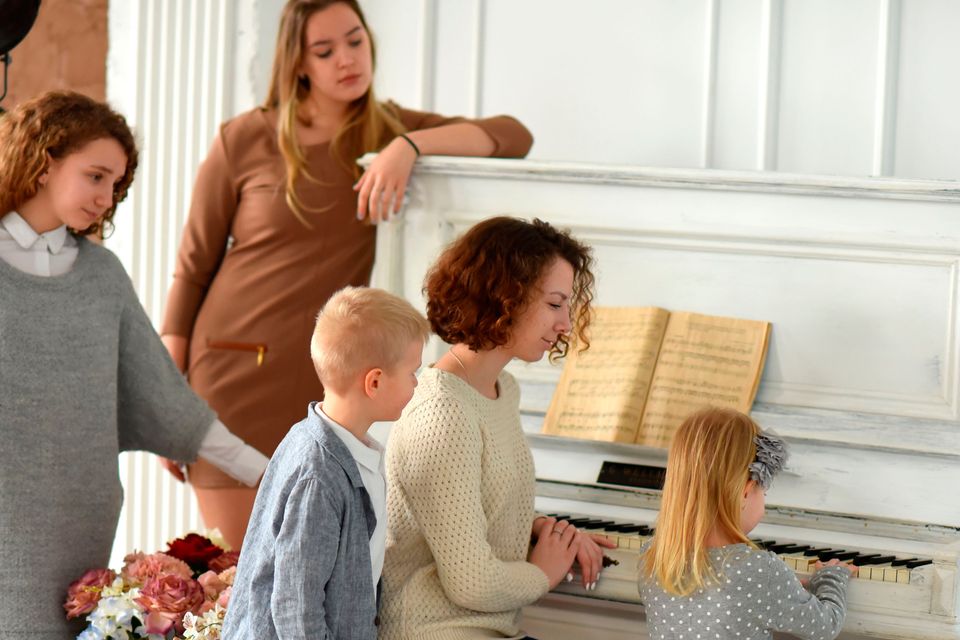Our family piano has 85 years of history to play out... with many more high notes yet to come
Musical memories: modern families rarely gather around pianos for a sing-song
Some decades ago - back in the 1930s - my mother acquired an upright piano which pleased her very much. It had, she told me, belonged to the Archbishop of Dublin, Dr John Charles McQuaid, when he was Dean of Blackrock College, and whether she purchased it from him directly or through another owner wasn't quite clear (Younger people, if you want to know something about a past episode of your family history, remember to ask while there is still someone alive who can answer. The day will come when there is no one left who knows).
In any case, it was a German piano, made by Schiedmayer and Soehne of Stuttgart, and '1809' was added to the manufacturer's monogram - although, as has subsequently become evident, that was just the date of the establishment of the company. This upright black piano was probably made in the early 1900s.
I have a vague notion it cost about £25 when my mother bought it (at a time when many people would have earned around a pound a week).
The piano was loved from the start. My aunt, Maureen, who was a music teacher, said it had an exceptionally fine "touch". Resonant.
It was placed in the drawing room (as best front rooms were then called) in our home in Herbert Road, Ballsbridge, and I remember just about everyone in the family playing it at one stage or other. My sister had piano lessons on it; my brother, James, developed a talent for playing music by ear. Ma played while she sang Ivor Novello's We'll Gather Lilacs in the Spring, which was a song of personal nostalgia for her. My aunt, Nora, played, and reverently sang Gounod's Ave Maria on it. It was a staple at parties when people would give their party piece or join in a general sing-song.
The Schiedmayer was even a witness to minor diplomatic history. During the Second World War, my father was the Honorary Consul for Chile (where he lived for a quarter of a century), thus my parents were part of the diplomatic circuit of entertaining.
Some time in the early 1940s, my parents gave a cocktail party, and the British, German, Japanese and Italian envoys were all present in that room together . Towards the end of the evening, somebody sat down and played the piano to friendly applause.
It was a source of wonder to Ma that the diplomatic representatives were all perfectly civil to one another in the presence of the Schiedmayer while bombing the hell out of one another - and worse - in the war sphere.
And so, the years of my childhood and growing up went by and, though ungifted at musical performance, I'd tinkle away at Chopsticks, or even strive to follow the sheet music (kept inside the piano stool) of The Tennessee Waltz. But, after Bill Haley hit Dublin and rock 'n' roll wrought its revolution, the piano lid was more often closed than opened.
The older generation grew too old for piano playing and, one by one, departed this world. The house was sold and the piano was despatched to cousins in England, who made excellent use of it - a young cousin, Peter Wilkinson, practised on it and became an accomplished musician.
Pianos, even upright ones, take up space in modern houses and, when musical students grow up and move away, the piano may again sit silent.
In the flurry of life, I lost track of where it went next - on long-term loan to various friends and family connections who could make use of it.
To be honest, I forgot about the piano for years. Over four decades of married life, we moved house seven times and all sorts of stuff got lost in the moves. I was recently informed by a moving company that I had "lost" a Victorian brass bed in a 2005 move.
But my son, Ed, had kept track of the piano and always intended to recover it one day.
Then, just a couple of weeks ago, he emailed me a snapshot of the old Schiedmayer, which he had now reclaimed - restored, tuned and installed in his home in north London, it looking as beguiling as ever. His wife had made him get rid of 80 books to make space for it, but space had been duly made.
Now their three young children are having their music lessons on the Schiedmayer and using it as an accompaniment for the many other instruments (guitar, mandolin, violin, ukulele) in which kids seem to be happily instructed these days. Every violin practice begins with hitting the note on a piano.
Times change, but the piano endures. To be able to play a piano is still a fine accomplishment and a source of collective pleasure.
The traditional soiree at which a pianist provides the music hasn't gone away. I attended a birthday party in January where a wonderful pianist performed a dazzling range of music from classical to jazz, from the American Songbook to folk, as well as rousing choruses in which all joined in, ending with the glorious piano glissando.
The old family piano has not only given pleasure over some 85 years, four generations and numerous collateral, but it has also sustained its monetary value. Well-conditioned Schiedmayers can sell for up to €12,000.
In so many ways, it was a priceless investment - in musical training and practice, in culture and entertainment, in memory and story. May it serve many more generations to come.
Join the Belfast Telegraph WhatsApp channel
Stay up to date with some of Northern Ireland's biggest stories

